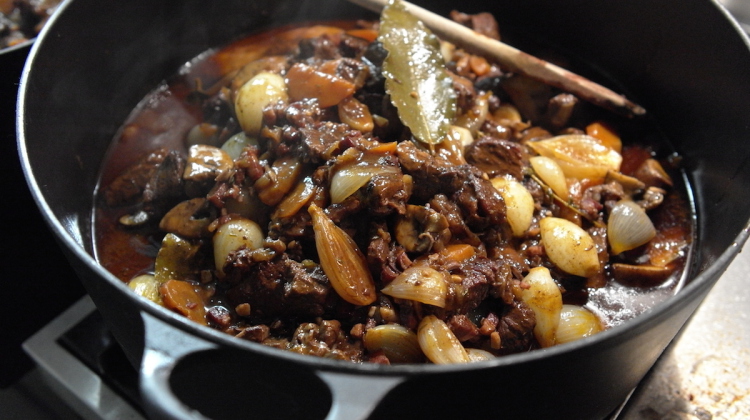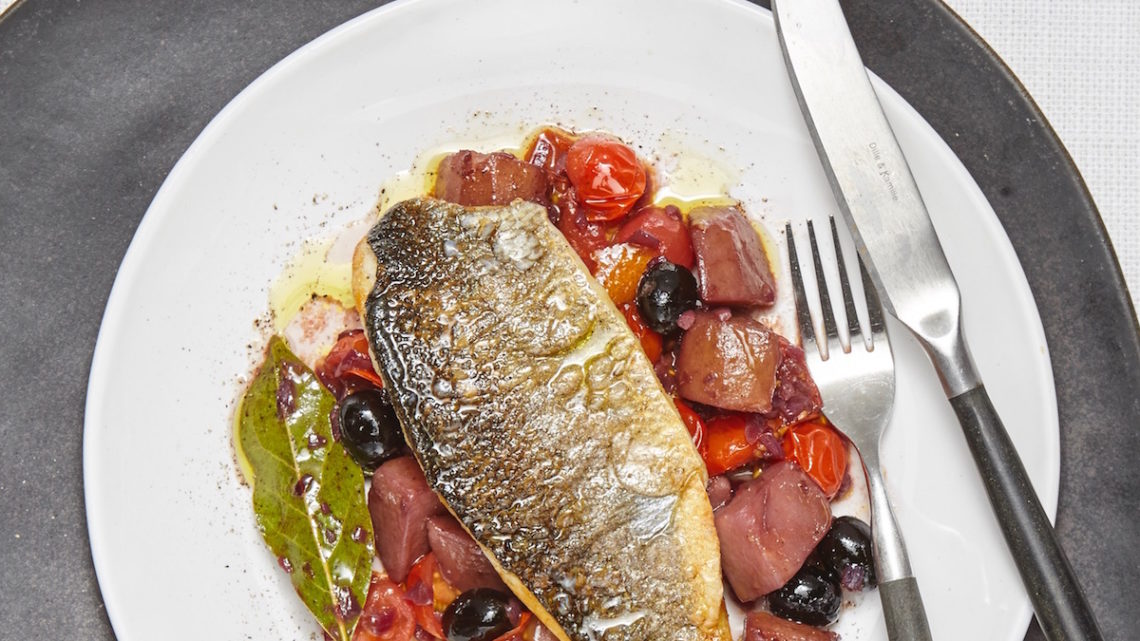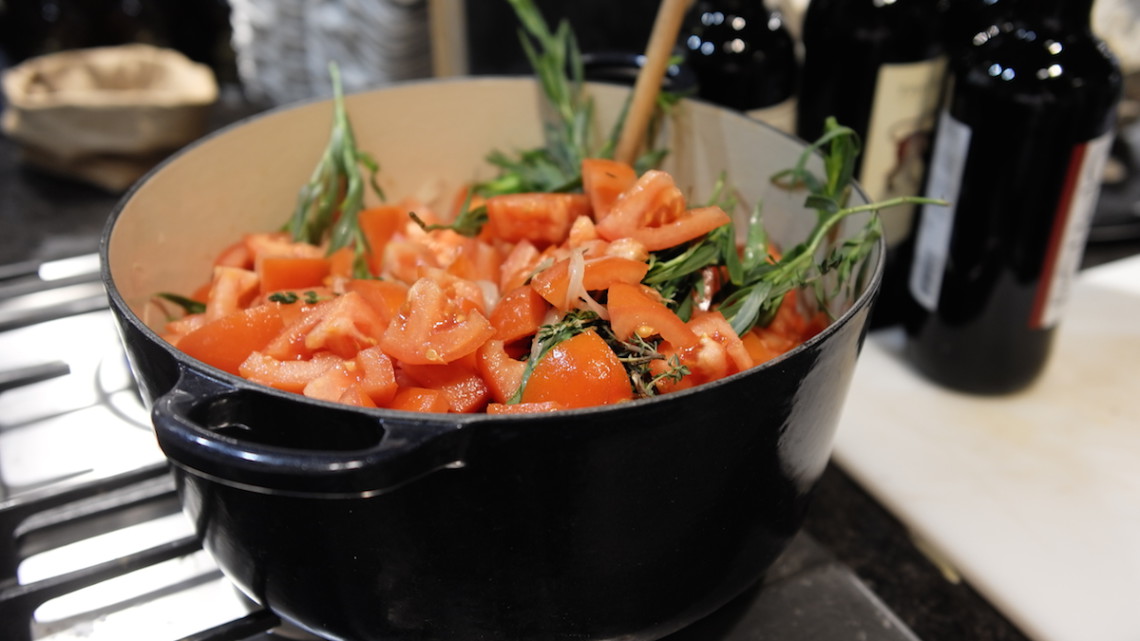Boeuf Bourguignon
After many years of searching and testing, we came to the conclusion that the legendary Julia Child had the definitive recipe. And we're not the only ones. Thomas Kellar, the brilliant Chef-Patron of the French Laundry in Napa Valley, California, also says that it's his go-to recipe for Boeuf Bourguignon. The best pan to use for a Boeuf Bourguignon is a Le Creuset cast iron as it spreads the heat quickly and evenly.
Serves 6
Ingredients and Method
180g piece of streaky bacon
Remove the rind and cut the bacon into lardons. Simmer the rind and bacon in 750ml water for 10 minutes. Drain and dry.
Preheat the oven to 220°C.
A large oven-proof pan
1 Tablespoon olive or sunflower oil
A slotted spoon
Sauté the bacon in the oil over moderate heat for 2-3 minutes to brown lightly. Remove to a side dish with a slotted spoon. Leave the oven-proof pan on the heat until the fat is almost smoking to sauté the beef.
1,5kg lean stewing steak, cut into 5cm cubes
Dry the beef; it will not brown if it is damp. Sauté it, a few pieces at a time, in the hot oil and bacon fat until nicely browned on all sides. Add it to the bacon.
1 sliced carrot
1 sliced onion
In the same fat, brown the sliced vegetables. Pour out the sautéing fat.
1 tsp salt
30g flour
¼ tsp pepper
Return the beef and bacon to the casserole and toss with the salt and pepper. Then sprinkle in the flour and toss again to coat the beef lightly with the flour. Place the casserole in the middle position of preheated oven for 4 minutes. Toss the meat and return to oven for 4 minutes more. (This browns the flour and covers the meat with a light crust.) Remove casserole and turn oven down to 160°C.
750ml full-bodied young red wine or a Chianti
500-600ml brown beef stock
1 Tbl tomato paste
2 cloves mashed garlic
½ tsp thyme
1 crumbled bay leaf
the blanched bacon rind
Stir in the wine and enough stock so that the meat is barely covered. Add the tomato paste, garlic, herbs and bacon rind. Bring to simmering point on top of stove. Then cover the casserole and place in the lower part of preheated oven. Regulate heat so that liquid simmers very slowly for 3-4 hours. The meat is done when a fork pierces it easily.
18-24 small onions, brown braised in stock
500g quartered fresh mushrooms, sautéed in butter
While the beef is cooking, prepare the onions and mushrooms. Leave them aside until needed.
When the meat is tender, pour the contents of the casserole into a sieve over a saucepan. Wash out the casserole and return the beef and bacon to it. Distribute the cooked onions and mushrooms over the meat.
Skim fat off the sauce. Simmer the sauce for a minute or two, skimming off additional fat as it rises. You should have about 600ml sauce thick enough to coat a spoon lightly. If too thin, boil down rapidly. If too thick, mix in a few tablespoons of stock. Taste carefully for seasoning. Pour the sauce over the meat and vegetables.
(*) Recipe may be completed in advance to this point.
Parsley sprigs
FOR IMMEDIATE SERVING
Cover the casserole and simmer for 2-3 minutes, basting the meat and vegetables with the sauce several times. Serve in its casserole, or arrange the stew on a dish surrounded with boiled potatoes, noodles or rice, and decorated with parsley.
FOR SERVING LATER
When cold, cover and refrigerate. About 15-20 minutes before serving, bring to simmering point, cover and simmer very slowly for 10 minutes, occasionally basting the meat and vegetables with the sauce.
We, the Amsterdam Flavours chefs, hope you enjoy this recipe as much as we do. If you have any questions on how to prepare it or just want to send us your feedback, you can reach us here Contact Amsterdam Flavours
Wine advice: Villa Wolf - Pinot Noir
Spanish Sea Bass
The deep flavours of red wine and citrus pair beautifully with sea bass, one of the most versatile and highly-regarded fish.
English
Serves 2
Ingredients
2 sea bass fillets of 150g each
200g cherry tomatoes
1 lemon
2 cloves garlic
1 sprig thyme
600g roseval potatoes
50g black olives
1 bay leaf
1 red onion
1 orange
5 tablespoon olive oil
100ml red wine
salt and pepper
Method
Finely chop the onion and garlic. Peel the potatoes and cut into chunks. Slice the cherry tomatoes in half.
Using a vegetable peeler, slice 3 pieces of zest from both the lemon and orange.
Heat a frying pan with 2 tablespoons olive oil and sweat the onion, garlic, potatoes and bay leaf, covered with a lid until the potatoes begin to soften. Deglaze with 100 ml red wine and the juice from half the orange. Reduce by half, then add the tomatoes, thyme, lemon and orange zest. Mix well and cook for 1 minute. Season with salt and pepper.
Remove the pin-bones from the sea bass with a fish tweezer and season the fillets with salt and pepper. Heat a frying pan with 2 tablespoons olive oil and fry the sea bass, skin-side down for 3 minutes. Turn the fish over a fry for a further 1 minute.
Divide the potatoes between 2 plates. Lay the fish on top, drizzle with a little extra olive oil and serve.
Nederlands
voor 2 personen
Ingrediënten
2 zeebaarsfilets a 150 gram per stuk
200g cherry tomaatjes
1 citroen
2 teentjes knoflook
1 takje tijm
600g roseval aardappeltjes
50g zwarte olijven
1 laurierblad
1 rode ui
1 sinaasappel
5 eetlepels olijfolie
100ml rode wijn
zout en peper
Bereiding
Snijd de ui en de knoflook fijn. Schil de aardappelen en snijd ze in grove blokjes. Snijd de tomaatjes in tweeen.
Trek 3 schilletjes van de citroen en de sinaasappel met een dunschiller.
Verwarm een koekenpan met 2 eetlepels olijfolie en smoor hierin het laurierblad, de ui , knoflook en de aardappels zachtjes, afgedekt met een deksel totdat de aardappelen gaar zijn. Blus af met de rode wijn en wat sap van ½ sinaasappel, kook voor de helft in. Voeg dan de tomaatjes, tijm, schilletjes van de sinaasappel en citroen toe en schep voorzichtig alles door elkaar, verwarm 1 minuut. Breng op smaak met zout en peper.
Verwijder de graatjes van de zeebaars met een pincet en bestrooi met zout en peper. Verwarm een koekenpan op medium vuur met 2 eetlepels olijfolie en bak de zeebaars, vel kant naar beneden 3 minuten. Draai om en bak nog 1 minuut.
Verdeel de aardappelen over 2 borden. Leg de vis er bovenop, druppel er wat olijfolie overheen en serveer direct.
Tomato Shallot Sauce
This is a super delicious sauce to serve with roasted beef. We usually serve it with a roasted Simmenthaler beef fillet. It requires a little care and time to make, but the results are so worth it.
Serves 6
Ingredients
6 shallots, chopped
1 clove garlic, chopped
35 g unsalted butter
8 ripe tomatoes, deseeded and roughly chopped
sprig of tarragon
sprig of thyme
1 bay leaf
250 ml red wine
200 ml dry Madeira
100 ml Port
300 ml veal or chicken stock
salt and freshly ground black pepper
Method
Gently cook the shallots and garlic in 20g of the butter until very soft. Purée in a blender and place in a clean pan with the tomatoes, tarragon, thyme and bay leaf. Cook gently for five minutes or until the tomatoes start to break down.
Add the red wine, bring to the boil and cook until the liquid is reduced by half. Pour in the Madeira and Port, boil and reduce again by half. Add the stock and bring to the boil. Skim and simmer for 30 minutes.
Pass the sauce through a fine sieve and pour into a clean pan, bring to the boil and cook for about two minutes or until the desired consistency is achieved. Whisk in the remaining butter and season with salt and freshly ground black pepper and keep warm until ready to use.
We, the Amsterdam Flavours chefs, hope you enjoy this recipe as much as we do. If you have any questions on how to prepare it or just want to send us your feedback, you can reach us here Contact Amsterdam Flavours
Artadi Tempranillo 12 Meses
Grape variety
100% Tempranillo
Region
Bodegas y Viñedos Artadi produce quality wines in three wine regions: Rioja Alavesa, Navarra and Alicante. To get the most from the different soil types, climatic conditions and characteristic grape varieties, they employ organic and biodynamic farming. In the Basque part of the Rioja, Alavesa, Artadi grows only tempranillo for the red wine. The bottom of the 83 hectares of vineyards mainly consists of calcareous soil, gravel and clay, at an altitude of about 700 meters above sea level. The climate is a whimsical combination of Oceanic and continental.
Vinification (wine-making)
Tempranillo grapes are used from vines that have an age averaging about 20 years old. After careful manual harvesting, the fruit gets a cold soaking of 24 to 48 hours followed by fermentation in stainless steel vats in which twice daily ' pigeage ' takes place (dipping the skins in the wine for more colour, smell and flavour extraction) and a slight remontage maceration (grape juice from the bottom of the tank is pumped again through the wine). This takes 10 to 12 days to complete. Maturation in wood takes 12 months, where only French oak used.
Taste impression
Intense, bright cherry-red colour. On the nose, lots of red fruit and black currant, roasted balsamic nuances, exotic wood and a hint of liquorice. Fresh in the starter, well structured and balanced, a full red wine with fine and elegant tannins and a catchy, lingering flavour.
Serving
Serve between 17 - 18 ° C. Decant the wine to separate the sediment and give it some aeration. Do this 30 minutes before serving to improve the wine's aroma. For serving, you can also use wide, large glass and pouring in only a little wine.Ageing potential: drink within 4 to 6 years after the harvest. Store in a cool and dark place.
Culinary advice
A good companion to richly flavoured Mediterranean dishes, particularly stews with meat or poultry, roasted or grilled lamb or pork, poultry, and mature, hard Spanish cheeses.
Taste type
Medium-bodied, very aromatic, with wood maturation.
Buy or taste this wine? For more information visit Wijnkoperij De Gouden Ton.
This wine is the perfect partner to our Beef Wellington.
Barbera d’Asti - La Vigna Vecchia - Red Wine
Origin:
The Cossetti family have been active in this wine region since 1891. Respecting tradition, but utilising new technology in considered doses, they have been producing distinctive wines here for many generations. In this part of Piemonte the soil is a mixture of clay and lime, perfect for sweet wines, white or ... red.
Preparation:
The grapes are harvested in the historic vineyard of this domain near Castelnuovo Belbo. The vines are more than 40 years old and provide a modest yield with a high fruit quality. Fermentation takes place in temperature controlled vats. By keeping the temperature low, the the characteristic properties of the Barbera grape are maintained. Maturation takes a minimum of 1 year and takes place in large oak casks with a capacity of 5000 liters. A part of the wine matures in barriques (barrels of 225 liters) that are used for one year. The wood influence remains controlled and gives the wine just that little extra complexity. After maturing the wines are assembled. In this way the beautiful characteristics in the wine come to the fore where the fruit plays a predominant role supported by the wood flavours. Large drums are used to aerate the wines very lightly and the wood has hardly any role to play.
Taste impression:
Red colour with purple impressions, a long intense aroma of red and black cherries with a gentle spiciness. The rich full flavour remains elegant with the characteristic Barbera freshness. Serve at 18 ° C.
Culinary advice:
Goes well with traditional appetizers, various white and red meat and medium-ripened semi-hard cheeses.
Buy or taste this wine? For more information visit Wijnkoperij De Gouden Ton
We Love Beef
We Love Beef shows how versatile beef is and how we should be using all of it from nose to tail.
In this book, two of Hollands most well known chefs, Alain Caron, known to most as a judge on the Dutch Masterchef and Richard van Oostenbrugge, excutive chef at restaurant Bord'eau at Amsterdam's De L'Europe Hotel have travelled to England to discover beef of superb quality and what can be done with it.
Each chapter in the book covers different sections of beef, for example the forequarter, hindquarter and offal. Why it's so useful is that special attention needs to be paid to the specific cuts when it comes to the cooking methods applied.
A brilliant addition to the book is the beef A-Z, with detailed information on the different cuts, their uses and cooking methods to achieve the best results.
Each chef has filled the book with personal recipes in each chapter. There is a wonderful range of home-style and restaurant-style recipes.
A great book which will introduce readers and cooks to new ways with beef.
Publisher: Carrera Culinair
Authors: Alain Caron & Richard van Oostenbrugge
Price: 25,00 euro
Featured wine: Enate - Tempranillo Joven - red wine
Origin:
Enate is located in the village of Salas Bajas, in Somontano. despite the relatively young age of this winery, founded in 1991, is already one of the most prestigious wineries in Spain. The purpose of Enate is to produce high-quality and premium wines from the best grapes of Somontano, with respect for the ancient local traditions and using the latest technology. The D.O. Somontano Located in the northeast of Spain, in the province of Huesca. It is also a fairly recent D.O. (1984), but also one of the most dynamic and respected in Spain. The vineyards for this hip tinto are 550-600 meters above sea level, protected through the Pyrenees. The humidity is low, partly due to the drying effect of soft winds. The soil consists of a mixture of sand and clay, poor and water permeable. Due to the height is the difference in temperature between day and night very large, 35 ° C during the day, 17-18 ° C at night. This gives the grapes additional complexity, power and aromatic taste.
Preparation:
The hand-picked grapes are de-stemmed, lightly crushed and fermented in stainless steel tanks at 24 ° C. After malolactic fermentation the young wine is clarified and stabilized to maintain the youthful and fruity character
Taste impression:
Beautiful, inviting color. very aromatic, with hints of red fruit (cherries, currants, strawberries), caramel and licorice. Fresh and lively in turn, round and soft on the tongue, mouth-filling, warm and fruity, with ripe and pleasant tannins and a creamy, mild finale.
Culinary advice:
This exuberantly fruity young wine is an excellent companion for example tapas! Particularly recommended for fish or shrimp croquettes, sausages (chorizo ), Spanish spiced meatballs, (...) but also at the table with pasta, rice dishes and even grilled lamb chops or meat skewers. In short, a versatile food wine for cozy, informal moments of pleasure, alone or - even better - in a group.
Buy or taste this wine? For more information visit Wijnkoperij De Gouden Ton
Every two weeks we will be giving away a bottle of the featured wine. To stand a chance of enjoying a bottle, fill out the contact form including the name of the wine and we will let you know if you have been selected.
Villa Wolf - Pinot Noir - Red wine
The wine:
Villa Wolf Pinot Noir is warm and medium-bodied, with a firm acid structure. Its dark cherry fruit is juicy, ripe, and forward, with a spicy mid-palate. Six months of barrique aging gives the wine a smoky depth and a nice touch of earthy tannins. This is a very grown-up Pinot Noir for the price, and it’s another excellent wine for everyday dining.
Culinary advice:
Perfect with various poultry like grouse, chicken and duck. Also good with veal with a variety of wild mushrooms. And off course a wonderful Boeuf Bourguignon.
The estate:
Founded in 1756, in the Pfalz region of Germany, the J.L. Wolf estate (now called Villa Wolf) was a successful and highly regarded winery for more than two centuries. It entered an especially glamorous era with the construction of its Italianate estate house and villa in 1843.
Since 2011, the estate has been managed by a talented and dedicated young couple who met while working at Dr. Loosen. Patrick Moellendorf and Sumi Gebauer have brought renewed energy and focus to the viticulture and winemaking at Villa Wolf.
The goal at Villa Wolf is to produce wines that express the pure, authentic terroir of the Pfalz. Made in the classic style of the Pfalz, Villa Wolf Rieslings are drier and more full-bodied than Mosel Rieslings, with fully ripe fruit flavors and a characteristic stoniness in the aroma.
The Pfalz region also has a long tradition with other grape varieties, allowing Ernst and his team to expand their winemaking palette to include Pinot Blanc, Pinot Gris, Pinot Noir, Gewürztraminer and Dornfelder. To preserve the naturally high quality of the vineyards, we employ sustainable viticultural practices and emphasize gentle handling of the fruit through traditional, minimalist winemaking.
Buy or taste this wine? For more information visit Wijnkoperij De Gouden Ton
Pears Baked in Red Wine
Serves 8
Ingredients
1 to 1½ bottles robust Italian red wine
rind of 1 lemon and 1 orange
2 cloves
½ cinnamon stick
4 peppercorns
1 bay leaf
200 g sugar
8 pears (Conference or Williams)
Method
Preheat the oven to 180° C. Place all the ingredients except the pears in a pan with a little extra water. Bring to the boil and simmer for 15 minutes.
Wash the pears, remove the core from underneath with a pomme Parisienne- bore (or with a teaspoon), leave the stalk on.
Place the pears in the pan, stalks pointing up. Bake in the oven without a lid for 1½ hours. In the beginning the pears should be almost covered with wine, later this will evaporate, leaving a sort of caramelized skin on the top of the pears.
Take the pears out of the cooking juice carefully so as not to break the skin, and place on a serving dish. Strain off the cooking juices and reduce until the syrupy in texture with a good rich flavour. Allow to cool slightly and serve with the pears.
This dish may be eaten hot or cold. Delicious served with ice cream or mascarpone flavoured with vanilla.
We, the Amsterdam Flavours chefs, hope you enjoy this recipe as much as we do. If you have any questions on how to prepare it or just want to send us your feedback, you can reach us here Contact Amsterdam Flavours





